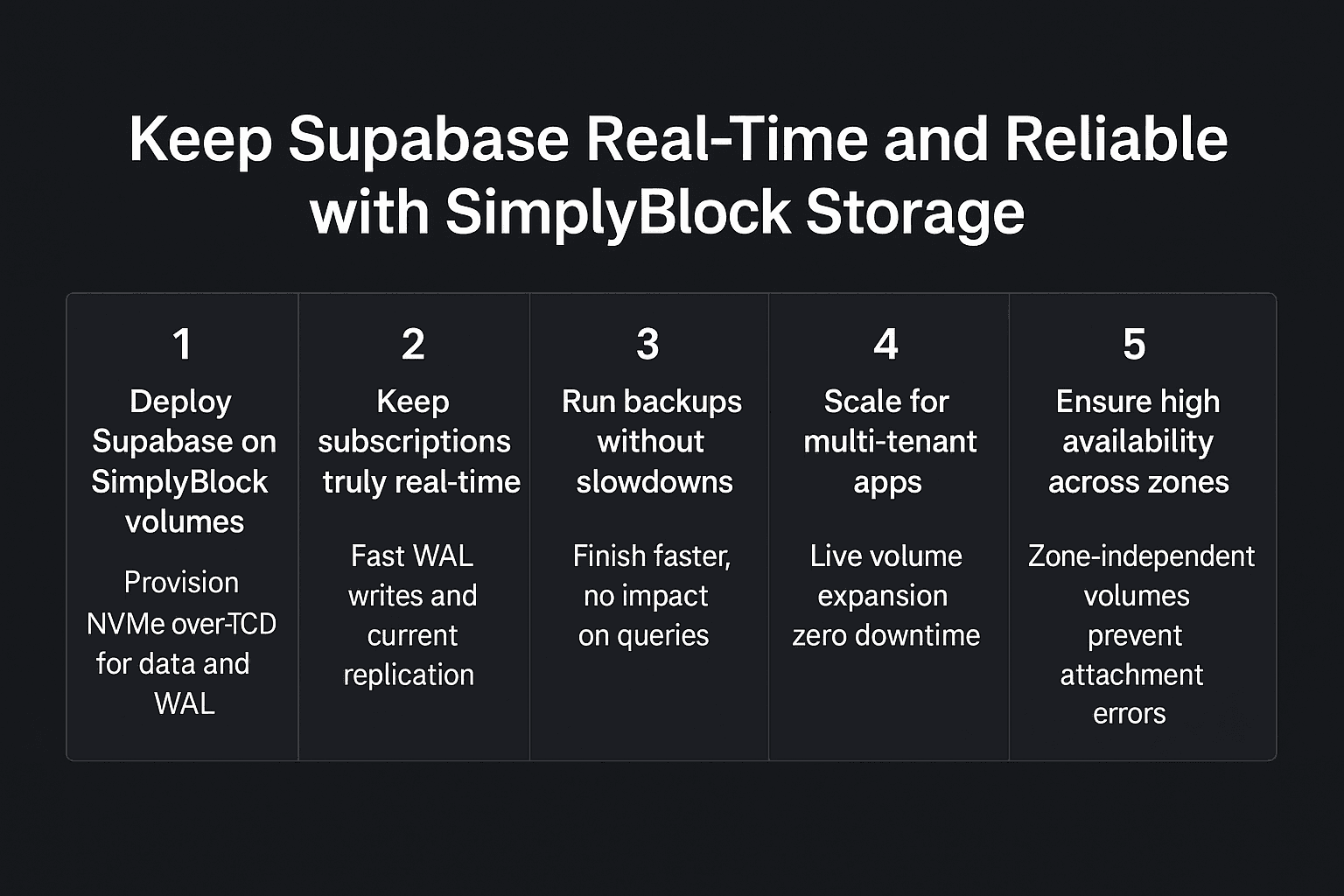Supabase is the go-to choice for developers who want to move fast, offering PostgreSQL with APIs, authentication, and real-time subscriptions—no extra setup needed. However, Supabase relies on PostgreSQL, which is only as reliable as the storage it uses. WAL writes, replication, and backups can slow down on standard cloud storage, causing laggy updates, slow failovers, and extended backup times.
Simplyblock solves this with NVMe-over-TCP, zone-resilient volumes, and live scalability, ensuring Supabase stays fast and reliable as apps and tenants grow.
Why Supabase Slows Down on Standard Storage
Supabase’s real-time API depends on PostgreSQL WAL files. When storage is slow, WAL commits drag, replication lags, and subscriptions fall behind. Backup processes make things worse by competing with queries. The result? Apps that should feel instant start to feel sluggish.
Simplyblock eliminates these bottlenecks. WAL files are written at NVMe speed, replication stays in sync, and backups complete faster. Developers get the Supabase experience they expect — responsive, real-time, and production-ready.
🚀 Use Simplyblock with Supabase for Scalable Applications
Give Supabase NVMe-level performance and zone resilience to keep apps responsive.
👉 Learn more about Disaggregated Storage with simplyblock →
Step 1: Deploy Supabase with Simplyblock Volumes
To get the best out of Supabase, its PostgreSQL backend should sit on fast, consistent storage. With simplyblock, you can provision NVMe-over-TCP volumes and mount them directly for Supabase data and WAL directories.
sbctl pool create –name supabase-pool
sbctl volume create –pool supabase-pool –size 200Gi –name supabase-data
mkfs.ext4 /dev/simplyblock/supabase-data
mount /dev/simplyblock/supabase-data /var/lib/postgresql/data
This ensures that Supabase APIs, queries, and subscriptions all run with NVMe-grade throughput. For more details, check out the Supabase Deployment Guide.

Step 2: Keep Real-Time Subscriptions Truly Real-Time
One of Supabase’s killer features is its real-time API. But that depends entirely on how quickly WAL changes can be written and streamed to clients. On slow volumes, updates lag and “real-time” becomes “eventually consistent.”
Simplyblock ensures WAL writes remain fast and replication stays current. That keeps subscriptions accurate and responsive, even under heavy traffic.
Step 3: Run Backups Without Disrupting Developer Workflows
Supabase automates backups, but these processes generate a lot of I/O. On standard disks, backup jobs slow down queries, authentication, and API responses — frustrating both users and developers.
With simplyblock, backups run quickly without affecting production workloads. Queries stay responsive, monitoring remains smooth, and backups finish in less time. This approach fits perfectly with Kubernetes backup strategies in modern app environments.
For more on Supabase’s backup strategies, refer to the Supabase Backup guide.
Step 4: Scale for Multi-Tenant Applications Without Downtime
Supabase often powers SaaS platforms with multiple tenants. That means unpredictable storage growth — one customer might be light, another might explode in data size overnight. On static volumes, that requires downtime or disruptive migrations.
Simplyblock volumes can expand live, keeping Supabase clusters running while you grow capacity.
sbctl volume resize –name supabase-data –size 500Gi
resize2fs /dev/simplyblock/supabase-data
This flexibility makes Supabase much more practical for databases as a service or any multi-tenant platform. For scaling Supabase for multi-tenant applications with minimal downtime, check the Supabase Architecture guide.
Step 5: Ensure High Availability Across Zones
Supabase promises developers reliability, but HA depends on the underlying infrastructure. When workloads reschedule across zones, zone-bound volumes break, delaying failovers and risking downtime.
Simplyblock volumes are zone-independent, so Supabase stays available across zones without attachment errors. Combined with reduction of RPO and RTO, this ensures failovers happen quickly, protecting apps from disruptions.
Supabase and Simplyblock – Built for Developers at Scale
Supabase makes building apps simple, but storage bottlenecks can undermine its promise of speed and reliability. Simplyblock removes those limits with NVMe performance, live scalability, and zone-resilient durability.
For SaaS platforms, real-time apps, and developer-first backends, Supabase with simplyblock means fewer headaches, faster performance, and infrastructure that scales as smoothly as your code.
Questions and Answers
Supabase depends on PostgreSQL for streaming and subscriptions, which require low-latency storage. Simplyblock provides NVMe-over-TCP storage that ensures real-time queries and updates remain consistent, even during traffic spikes, avoiding the lag often seen with traditional cloud storage.
Yes. Supabase applications can hit IOPS or throughput limits on standard cloud disks. By running Supabase on simplyblock, you benefit from database performance optimization, enabling faster queries, smoother scaling, and reduced risk of downtime caused by storage bottlenecks.
Supabase can run on Kubernetes, but storage is often the limiting factor. Simplyblock integrates via its Kubernetes CSI driver, delivering dynamic scaling, snapshots, and high IOPS. This makes Supabase deployments more resilient and significantly faster than relying on default Kubernetes storage classes.
When running Supabase, securing PostgreSQL storage is critical. Simplyblock offers encryption at rest per volume or per tenant, ensuring compliance with GDPR or HIPAA without sacrificing performance. This is especially important for production apps handling sensitive customer data.
Absolutely. Supabase workloads often require scaling database storage, which quickly increases cloud bills. Simplyblock enables cloud cost optimization by consolidating volumes and maximizing IOPS per dollar, making Supabase hosting more predictable and cost-effective.

